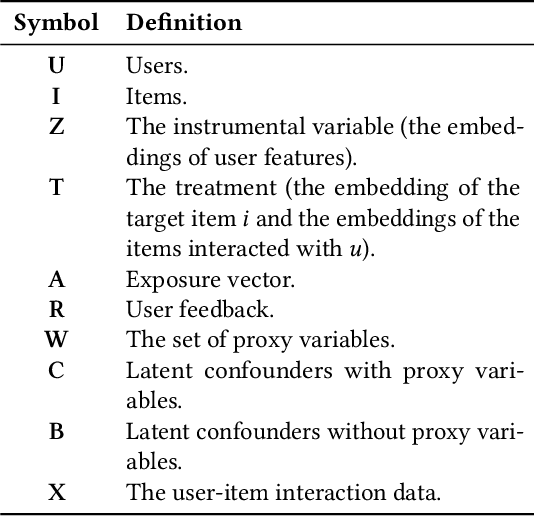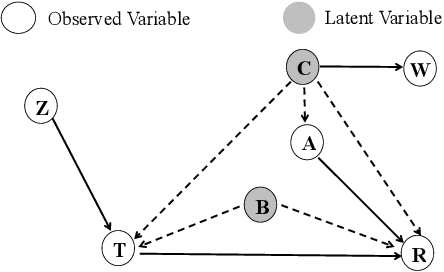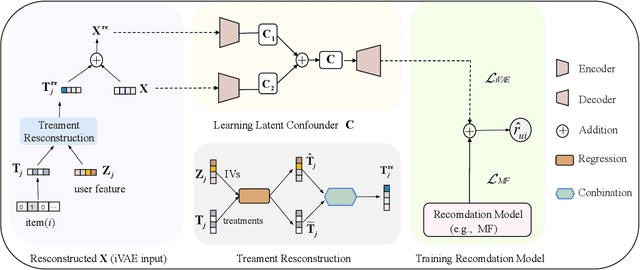Xiaojing Du
Deconfounding Time Series Forecasting
Oct 27, 2024Abstract:Time series forecasting is a critical task in various domains, where accurate predictions can drive informed decision-making. Traditional forecasting methods often rely on current observations of variables to predict future outcomes, typically overlooking the influence of latent confounders, unobserved variables that simultaneously affect both the predictors and the target outcomes. This oversight can introduce bias and degrade the performance of predictive models. In this study, we address this challenge by proposing an enhanced forecasting approach that incorporates representations of latent confounders derived from historical data. By integrating these confounders into the predictive process, our method aims to improve the accuracy and robustness of time series forecasts. The proposed approach is demonstrated through its application to climate science data, showing significant improvements over traditional methods that do not account for confounders.
Mitigating Dual Latent Confounding Biases in Recommender Systems
Oct 16, 2024



Abstract:Recommender systems are extensively utilised across various areas to predict user preferences for personalised experiences and enhanced user engagement and satisfaction. Traditional recommender systems, however, are complicated by confounding bias, particularly in the presence of latent confounders that affect both item exposure and user feedback. Existing debiasing methods often fail to capture the complex interactions caused by latent confounders in interaction data, especially when dual latent confounders affect both the user and item sides. To address this, we propose a novel debiasing method that jointly integrates the Instrumental Variables (IV) approach and identifiable Variational Auto-Encoder (iVAE) for Debiased representation learning in Recommendation systems, referred to as IViDR. Specifically, IViDR leverages the embeddings of user features as IVs to address confounding bias caused by latent confounders between items and user feedback, and reconstructs the embedding of items to obtain debiased interaction data. Moreover, IViDR employs an Identifiable Variational Auto-Encoder (iVAE) to infer identifiable representations of latent confounders between item exposure and user feedback from both the original and debiased interaction data. Additionally, we provide theoretical analyses of the soundness of using IV and the identifiability of the latent representations. Extensive experiments on both synthetic and real-world datasets demonstrate that IViDR outperforms state-of-the-art models in reducing bias and providing reliable recommendations.
Causal GNNs: A GNN-Driven Instrumental Variable Approach for Causal Inference in Networks
Sep 13, 2024Abstract:As network data applications continue to expand, causal inference within networks has garnered increasing attention. However, hidden confounders complicate the estimation of causal effects. Most methods rely on the strong ignorability assumption, which presumes the absence of hidden confounders-an assumption that is both difficult to validate and often unrealistic in practice. To address this issue, we propose CgNN, a novel approach that leverages network structure as instrumental variables (IVs), combined with graph neural networks (GNNs) and attention mechanisms, to mitigate hidden confounder bias and improve causal effect estimation. By utilizing network structure as IVs, we reduce confounder bias while preserving the correlation with treatment. Our integration of attention mechanisms enhances robustness and improves the identification of important nodes. Validated on two real-world datasets, our results demonstrate that CgNN effectively mitigates hidden confounder bias and offers a robust GNN-driven IV framework for causal inference in complex network data.
A Deconfounding Approach to Climate Model Bias Correction
Aug 22, 2024



Abstract:Global Climate Models (GCMs) are crucial for predicting future climate changes by simulating the Earth systems. However, GCM outputs exhibit systematic biases due to model uncertainties, parameterization simplifications, and inadequate representation of complex climate phenomena. Traditional bias correction methods, which rely on historical observation data and statistical techniques, often neglect unobserved confounders, leading to biased results. This paper proposes a novel bias correction approach to utilize both GCM and observational data to learn a factor model that captures multi-cause latent confounders. Inspired by recent advances in causality based time series deconfounding, our method first constructs a factor model to learn latent confounders from historical data and then applies them to enhance the bias correction process using advanced time series forecasting models. The experimental results demonstrate significant improvements in the accuracy of precipitation outputs. By addressing unobserved confounders, our approach offers a robust and theoretically grounded solution for climate model bias correction.
Estimating Peer Direct and Indirect Effects in Observational Network Data
Aug 21, 2024



Abstract:Estimating causal effects is crucial for decision-makers in many applications, but it is particularly challenging with observational network data due to peer interactions. Many algorithms have been proposed to estimate causal effects involving network data, particularly peer effects, but they often overlook the variety of peer effects. To address this issue, we propose a general setting which considers both peer direct effects and peer indirect effects, and the effect of an individual's own treatment, and provide identification conditions of these causal effects and proofs. To estimate these causal effects, we utilize attention mechanisms to distinguish the influences of different neighbors and explore high-order neighbor effects through multi-layer graph neural networks (GNNs). Additionally, to control the dependency between node features and representations, we incorporate the Hilbert-Schmidt Independence Criterion (HSIC) into the GNN, fully utilizing the structural information of the graph, to enhance the robustness and accuracy of the model. Extensive experiments on two semi-synthetic datasets confirm the effectiveness of our approach. Our theoretical findings have the potential to improve intervention strategies in networked systems, with applications in areas such as social networks and epidemiology.
MRC-based Nested Medical NER with Co-prediction and Adaptive Pre-training
Mar 23, 2024



Abstract:In medical information extraction, medical Named Entity Recognition (NER) is indispensable, playing a crucial role in developing medical knowledge graphs, enhancing medical question-answering systems, and analyzing electronic medical records. The challenge in medical NER arises from the complex nested structures and sophisticated medical terminologies, distinguishing it from its counterparts in traditional domains. In response to these complexities, we propose a medical NER model based on Machine Reading Comprehension (MRC), which uses a task-adaptive pre-training strategy to improve the model's capability in the medical field. Meanwhile, our model introduces multiple word-pair embeddings and multi-granularity dilated convolution to enhance the model's representation ability and uses a combined predictor of Biaffine and MLP to improve the model's recognition performance. Experimental evaluations conducted on the CMeEE, a benchmark for Chinese nested medical NER, demonstrate that our proposed model outperforms the compared state-of-the-art (SOTA) models.
 Add to Chrome
Add to Chrome Add to Firefox
Add to Firefox Add to Edge
Add to Edge